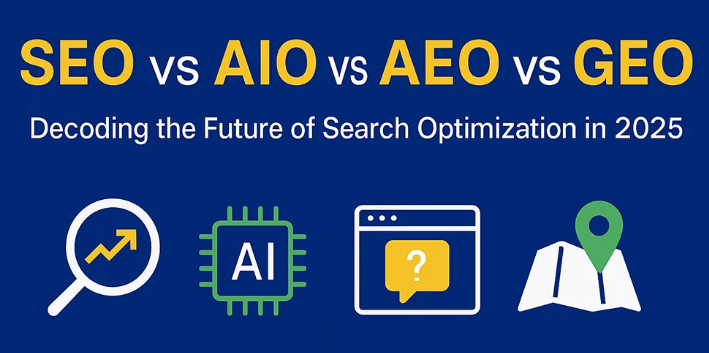The landscape of search and content discovery is undergoing a fundamental transformation. While traditional Search Engine Optimization (SEO) remains relevant, three new paradigms—AI SEO, Answer Engine Optimization (AEO), and Generative Engine Optimization (GEO)—are reshaping how content gets discovered and consumed. Understanding these concepts isn't just academic; it's essential for anyone who wants their content to remain visible in an AI-driven world.
Understanding the Four Optimization Paradigms
SEO (Search Engine Optimization)
SEO is the established practice of optimizing websites to rank higher in traditional search engine results pages (SERPs). It focuses on keywords, backlinks, technical performance, and user experience signals to satisfy algorithms like Google's PageRank and its successors. SEO aims to drive organic traffic by appearing prominently when users type queries into search engines.
Key characteristics:
- Targets traditional search engines (Google, Bing)
- Focuses on ranking in blue-link results
- Emphasizes keywords, backlinks, and technical SEO
- Success measured by rankings, traffic, and click-through rates
AI SEO (AI-Enhanced Search Engine Optimization)
AI SEO represents the evolution of traditional SEO practices enhanced by artificial intelligence capabilities. It involves both optimizing for AI-powered search features (like Google's AI Overviews, formerly SGE) and using AI tools to improve optimization strategies. This includes understanding how AI algorithms interpret content, user intent, and context at a deeper semantic level.
Key characteristics:
- Incorporates AI-powered search features (AI Overviews, Featured Snippets 2.0)
- Uses AI tools for content creation, analysis, and optimization
- Focuses on semantic search and natural language understanding
- Adapts traditional SEO practices for AI-enhanced search engines
AEO (Answer Engine Optimization)
AEO is the practice of optimizing content to be selected as the direct answer source for voice assistants, featured snippets, knowledge panels, and other answer-focused platforms. Unlike traditional SEO, which drives traffic to websites, AEO often provides information directly to users without requiring a click-through. Think of Alexa, Siri, Google Assistant, and featured snippets that answer questions immediately.
Key characteristics:
- Targets voice assistants and answer boxes
- Provides direct answers without requiring site visits
- Emphasizes structured data and concise, authoritative responses
- Focuses on question-based queries and conversational language
GEO (Generative Engine Optimization)
GEO is the newest frontier—optimizing content to be cited, referenced, and included in responses from generative AI systems like ChatGPT, Claude, Perplexity, and Google's Gemini. These AI systems synthesize information from multiple sources to generate comprehensive answers. GEO focuses on making your content authoritative, citable, and structured in ways that AI models can understand and reference.
Key characteristics:
- Targets generative AI platforms (ChatGPT, Claude, Perplexity, Gemini)
- Aims for citation and attribution in AI-generated responses
- Emphasizes authoritative, well-structured, factual content
- Focuses on being a trusted source for AI training and retrieval
Comprehensive Comparison Table
| Aspect | Traditional SEO | AI SEO | AEO | GEO |
|---|---|---|---|---|
| Primary Platform | Google, Bing search results | AI-enhanced search engines | Voice assistants, answer boxes | ChatGPT, Claude, Perplexity, Gemini |
| Main Goal | Drive traffic to website | Drive traffic + appear in AI features | Provide direct answers | Be cited in AI responses |
| User Journey | Click-through to website | Mixed (some click, some answer) | Answer without click | Answer with potential attribution |
| Content Format | Comprehensive articles, pages | Semantic, contextual content | Concise, direct answers | Authoritative, citable content |
| Key Signals | Keywords, backlinks, PageRank | Semantic relevance, E-E-A-T | Structured data, question-answer format | Credibility, citations, factual accuracy |
| Measurement | Rankings, traffic, conversions | Visibility in AI features + traffic | Featured snippet appearances, voice share | Citation frequency, brand mentions |
| Technical Requirements | Meta tags, sitemaps, site speed | Schema markup, semantic HTML | Structured data, FAQ schema | Clear attribution, source documentation |
| Content Strategy | Keyword-optimized content | Intent-focused, comprehensive | Question-focused, precise | Expert-level, well-researched |
| Optimization Timeframe | Months to see results | Weeks to months | Days to weeks for answers | Ongoing, longer-term trust building |
| Traffic Impact | Direct and measurable | Partially measurable | Often zero-click | Indirect (brand awareness) |
Detailed Comparisons: How Each Relates to Traditional SEO
AI SEO vs. Traditional SEO
AI SEO builds directly on traditional SEO foundations but adapts them for AI-powered search experiences:
Similarities:
- Both aim to improve visibility in search results
- Both value high-quality, relevant content
- Both require technical optimization
Key Differences:
- Intent Understanding: AI SEO requires deeper understanding of semantic intent beyond keyword matching
- Content Depth: AI favors comprehensive, contextually rich content over keyword-stuffed pages
- User Signals: AI SEO relies more heavily on engagement metrics and behavioral data
- Featured Positions: AI SEO prioritizes appearing in AI Overviews and enhanced results, not just rankings
- Optimization Tools: AI SEO leverages machine learning tools for content analysis and optimization
Relationship: AI SEO is an evolution, not a replacement. Traditional SEO skills remain the foundation, but practitioners must layer on understanding of how AI interprets and prioritizes content.
AEO vs. Traditional SEO
AEO represents a paradigm shift from driving traffic to providing direct value:
Similarities:
- Both require authoritative, accurate content
- Both benefit from structured data
- Both consider user experience
Key Differences:
- Success Metric: AEO often succeeds through zero-click answers; SEO measures clicks
- Content Length: AEO favors concise, direct answers; SEO often favors longer, comprehensive content
- Query Type: AEO targets question-based queries; SEO handles broader query types
- Monetization: AEO challenges traditional traffic-based revenue models
- Format: AEO requires answer-first formatting; SEO allows more varied structures
Relationship: AEO can be seen as complementary or competitive to SEO. Smart content strategies address both—providing quick answers while encouraging deeper engagement for those who want more information.
GEO vs. Traditional SEO
GEO operates in a fundamentally different ecosystem where AI systems are the gatekeepers:
Similarities:
- Both value authoritative, high-quality content
- Both benefit from clear, well-structured information
- Both require technical competence
Key Differences:
- Visibility Location: GEO aims for citations in AI responses; SEO aims for search result positions
- Direct Traffic: GEO generates minimal direct traffic; SEO's primary goal is traffic
- Content Depth: GEO requires extremely high factual accuracy and expertise; SEO can succeed with good-enough content
- Authority Signals: GEO heavily weighs citations and references; SEO values backlinks
- Update Frequency: GEO benefits from keeping content current for AI system updates; SEO has more gradual algorithm updates
Relationship: GEO represents a new channel rather than an evolution of SEO. It requires thinking about your content as reference material for AI systems, not just for human searchers. The two can coexist—strong SEO content can also be GEO-optimized.
Why Optimize for These New Paradigms?
The Changing User Behavior
Users increasingly expect immediate, AI-generated answers rather than clicking through multiple websites. According to recent trends:
- Voice search queries are growing exponentially
- Zero-click searches (where users get answers without clicking) now account for a significant portion of searches
- AI chatbots are becoming primary research tools for many users
- Younger demographics prefer conversational AI over traditional search
The Risk of Invisibility
If your content isn't optimized for these new systems, you risk becoming invisible:
- Traffic Decline: As AI provides more direct answers, traditional click-through rates are declining
- Brand Awareness: Even without clicks, being cited by AI systems builds brand authority
- Competitive Disadvantage: Competitors who adapt early will capture the attention of AI-assisted users
- Future-Proofing: These trends will only accelerate; early adoption provides strategic advantage
The Opportunity for Authority
These new paradigms reward expertise and authority more than ever:
- AI systems prioritize credible, well-researched sources
- Being cited by AI builds trust with users who see your brand associated with accurate information
- Expert content has lasting value across multiple platforms
- Quality becomes the ultimate competitive advantage
Who Should Prioritize Each Optimization Strategy?
Recommended for Traditional SEO
Best suited for:
- E-commerce websites needing direct product sales
- Local businesses targeting geographic searches
- Service providers requiring consultation bookings
- Anyone whose business model depends on website visits
Why it matters: If your revenue depends on getting users to your website, traditional SEO remains critical. You need those clicks.
Recommended for AI SEO
Best suited for:
- Content publishers adapting to AI-enhanced search
- B2B companies targeting informed researchers
- Educational institutions and online course providers
- Businesses in competitive industries needing every visibility advantage
Why it matters: AI SEO helps you maintain visibility as search evolves, bridging traditional SEO and newer paradigms.
Recommended for AEO
Best suited for:
- Information sites and publishers (news, how-to, education)
- Brands focusing on awareness over immediate conversions
- Businesses targeting voice search users
- FAQ-heavy industries (healthcare, technology, finance)
Why it matters: If your goal is brand awareness, thought leadership, or providing public value, being the answer source builds credibility even without clicks.
Recommended for GEO
Best suited for:
- Research institutions and academic organizations
- Industry thought leaders and expert consultants
- B2B SaaS companies targeting technical audiences
- Media companies and authoritative publishers
- Professional service providers (legal, medical, financial)
Why it matters: GEO positions you as the trusted source that AI systems reference, building long-term authority and brand value in the AI era.
Universal Recommendation
Everyone should adopt a hybrid strategy that includes elements of all four approaches, weighted according to your specific goals, audience, and business model.
How Website Owners and Webmasters Can Embrace the Change
1. Shift Your Mindset from Traffic to Value
The Old Approach: Obsess over traffic numbers and rankings The New Approach: Focus on being the authoritative source, regardless of how users consume your content
Recognize that visibility in AI responses, even without clicks, builds brand equity and positions you as an industry leader. Your content's value extends beyond direct traffic.
2. Invest in Exceptional Content Quality
All four optimization paradigms reward one thing above all: high-quality, accurate, well-researched content.
Actionable steps:
- Hire or consult with subject matter experts
- Implement rigorous fact-checking processes
- Create comprehensive, authoritative resources
- Update content regularly to maintain accuracy
- Add clear citations and sources to your own content
3. Structure Content for Both Humans and AI
Technical implementation:
- Use semantic HTML5 (proper heading hierarchy, article tags, etc.)
- Implement comprehensive schema markup (Article, FAQPage, HowTo, etc.)
- Create clear, logical content hierarchies
- Include both quick answers and deep dives in the same piece
- Use descriptive, meaningful URLs and file names
4. Optimize for Questions and Answers
Content strategy:
- Research the questions your audience asks (use tools like AnswerThePublic, People Also Ask)
- Create dedicated FAQ sections
- Format content with clear question headings
- Provide concise, direct answers followed by detailed explanations
- Use natural, conversational language
5. Build E-E-A-T (Experience, Expertise, Authoritativeness, Trustworthiness)
This Google concept applies across all optimization paradigms:
Implementation:
- Display author credentials prominently
- Link to authoritative external sources
- Earn mentions and citations from other reputable sites
- Showcase real-world experience and case studies
- Maintain transparency about content creation and updates
6. Diversify Your Metrics
Beyond traditional analytics:
- Monitor brand mention frequency in AI tools (manually test your topics in ChatGPT, Claude, Perplexity)
- Track featured snippet and answer box appearances
- Measure branded search volume as an authority indicator
- Monitor social signals and industry recognition
- Assess content longevity and evergreen performance
7. Create Multiple Content Formats
Different platforms and optimization types favor different formats:
Content portfolio:
- Long-form articles: For traditional SEO and comprehensive coverage
- FAQ pages: For AEO and question-based queries
- Data-driven studies: For GEO and citation potential
- Concise explainers: For AI SEO and quick answers
- Visual content: Infographics, charts for multi-modal AI
8. Maintain Technical Excellence
All optimization paradigms require solid technical foundations:
Technical priorities:
- Fast page load speeds (Core Web Vitals)
- Mobile-responsive design
- Secure connections (HTTPS)
- Clean, crawlable site architecture
- XML sitemaps and proper robots.txt configuration
- Structured data without errors
9. Build Relationships and Authority
Offline and online:
- Contribute to industry publications
- Speak at conferences and webinars
- Participate in expert panels
- Engage in meaningful professional networking
- Earn natural, editorial backlinks through quality
10. Stay Informed and Adapt
The landscape continues evolving rapidly:
Continuous learning:
- Follow industry news from sources like Search Engine Journal, Search Engine Land
- Test new AI platforms regularly
- Join professional communities and forums
- Experiment with emerging tools and techniques
- Be prepared to pivot strategies as the ecosystem changes
A Practical Action Plan for Website Owners
Phase 1: Foundation (Months 1-2)
- Audit current content for quality and accuracy
- Implement or improve schema markup
- Establish author profiles and E-E-A-T signals
- Identify core topics where you can be authoritative
Phase 2: Optimization (Months 3-4)
- Create or enhance FAQ content for key topics
- Restructure existing content with clear hierarchies
- Add comprehensive, well-sourced answers to common questions
- Optimize for semantic search and natural language
Phase 3: Expansion (Months 5-6)
- Create authoritative, citation-worthy resources (research, data, comprehensive guides)
- Test content visibility in various AI platforms
- Build relationships for natural link acquisition
- Develop content across multiple formats
Phase 4: Measurement and Iteration (Ongoing)
- Monitor performance across all channels (traditional search, AI features, citations)
- Gather user feedback and adjust content
- Update content regularly to maintain relevance
- Experiment with new platforms and optimization techniques
Conclusion: Embrace Change as Opportunity
The evolution from SEO to AI SEO, AEO, and GEO isn't a threat—it's an opportunity to elevate content quality and establish genuine authority. While the channels and metrics may change, the fundamental principle remains: provide exceptional value to your audience.
Website owners who view these changes as a challenge to create better, more authoritative, more helpful content will thrive. Those who resist and cling to outdated tactics will find themselves increasingly invisible in an AI-driven world.
The future of content discovery is here. The question isn't whether to adapt, but how quickly you can embrace these new paradigms while maintaining the SEO fundamentals that still matter. Start today by auditing your content through the lens of these four optimization approaches, and commit to being the source that humans and AI systems alike recognize as authoritative.
Your content's value isn't diminished by new technology—if anything, truly valuable content has never been more important. Make the investment, embrace the change, and position yourself as the trusted source in your industry, regardless of how users choose to find and consume information.









